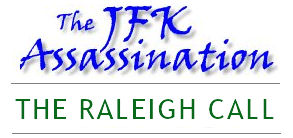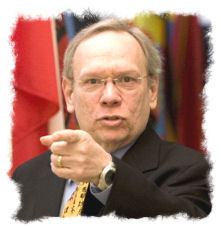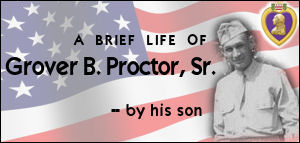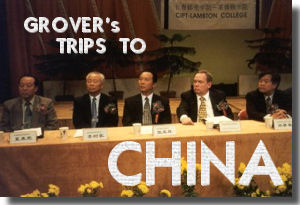|
DRAFT
Book 3
VIII. E7
JOHN HURT ALLEGATION:
Is it true that Lee Harvey Oswald attempted to call John Hurt of Raleigh, North Carolina, a former U.S. Army Intelligence Officer, on November 23, 1963 from the Dallas City Jail?
By Surell Brady
Senior Staff Counsel
House Select Committee on Assassinations
In August 1977 the House Select Committee on Assassinations received information that Oswald had allegedly attempted to place a call from the Dallas City Jail on the night of November 23, 1963 to John Hurt in Raleigh, North Carolina. In addition to what it might reveal about Oswald's associates, this information was also considered important because of an additional allegation that Hurt was connected with U.S. Army Intelligence. The information about the call came to the Committee from Alveeta Treon, who was employed at the time of the assassination at the Dallas City Hall as a switchboard operator.
In August 1977 the Committee also received an undated and unsigned affidavit concerning the circumstances of the alleged phone call, and a form used to record information on long distance calls made from the Dallas City Hall was attached to the affidavit.
The affidavit was sent to the Committee by Jim Kostman of the Assassinations Information Bureau.1 Kostman informed the Committee he found an unsigned and undated carbon copy of the affidavit in the files of the Committee to Investigate Assassinations in Washington, D.C. and he forwarded a copy of that carbon to the HSCA.2 He had no information about the origin of the affidavit.3
The Committee sent a copy of the affidavit to Mrs. Treon for her to authenticate.4 Mrs. Treon made corrections to the facts contained in the copy and returned it to the Committee.5 She told Committee staff that she had never before seen the affidavit nor prepared one and she did not know who had written it.6
According to the information contained in the corrected affidavit, Mrs. Treon stated that on the night of November 23, 1963 she was assigned to work the 11:00 p.m. to 7:00 a.m. shift at the City Hall switchboard; she arrived for work early that evening, at approximately 10:15 p.m.7 At that time another switchboard employee, Mrs. Louise Swinney, was still at work.8 Mrs. Swinney was scheduled to leave work at 11:00 p.m.9 When Mrs. Treon started work, Mrs. Swinney informed her that two law enforcement officials would be coming into the switchboard room that night to be present when Lee Harvey Oswald made a call from the jail and that Mrs. Swinney had instructions from her superiors for her and Mrs. Treon to cooperate.10 Mrs. Swinney informed Mrs. Treon that the law enforcement officials would listen in on the call made by Oswald.11
Mrs. Treon stated that after about ten or fifteen minutes two men entered the room and showed their identification to Mrs. Swinney.12 The men went into the equipment room.13 A few minutes later a red light appeared on the switchboard, indicating that a call was being made from the jail.14 Mrs. Swinney handled the call.
Mrs. Treon said that even though both she and Mrs. Swinney "plugged in" to take the call at the same time, Mrs. Swinney gave the impression that she intended to handle the call, as though that was part of the "instructions" she had received.15 However, Mrs. Treon stayed on the line during the call and heard Oswald give the information for the number he wanted to call.16 Mrs. Treon stated that Oswald gave the name John Hurt and two numbers.17 As she listened, Mrs. Treon wrote the information on a telephone call slip used by the Dallas City Hall operators.18 She said she signed Mrs. Swinney's name to the slip since Mrs. Swinney had actually handled the call; she then kept the slip as a souvenir.19 Mrs. Treon's daughter Sharon was present at the time in the switchboard room and had earlier asked her mother to get a souvenir of Oswald's call.20 The daughter, Sharon Kovac, also worked in the City Hall and had the habit of visiting her mother at the switchboard to sit and talk.21
In a telephone interview with Committee staff on December 6, 1978, Sharon Kovac stated that she was employed at the time of the assassination by the Dallas Police Department as a stenographer in the records office.22 On the night of November 23, 1963 Ms. Kovac was working the 10:30 p.m. to 6:30 a.m. shift.23 During the night she went into the switchboard room to talk with her mother as she often did when they were both working.24 Ms. Kovac recalled in the interview that her mother had received word before Ms. Kovac arrived that Oswald was going to make a call that night from the jail.25 Ms. Kovac asked her mother to get a souvenir of the call for her.26
Ms. Kovac remembers that two men in business suits came into the switchboard equipment room a short time later to be present when Oswald made the call.27 Ms. Kovac said she had never seen either of the men before and therefore believes they were not employed by the Dallas Police Department because she was familiar with most people there from her work in the Department.28
Ms. Kovac recalls that when Oswald attempted to place his call, her mother was on the line.29 Ms. Kovac said that she cannot recall if anyone else was present at the switchboard.30 She said she saw her mother write the details of the call as she listened on the line.31 Ms. Kovac said she does not think the person Oswald wanted to call answered and the call was not completed.32
Ms. Kovac said that sometime later her mother gave her a copy of the telephone call slip which she had prepared that night.33
Mrs. Treon said that she saw Mrs. Swinney write the details of the call down on a note pad.34 Mrs. Swinney repeated the number to Oswald.35 She then closed the key and called in to the men in the equipment room and said that Oswald was personally placing a call.36 According to Mrs. Treon, Mrs. Swinney appeared very nervous and seemed to be trembling.37
As Mrs. Treon watched, Mrs. Swinney did not place the call for Oswald. Instead, she opened the key on Oswald's line and told him, "I am sorry the number doesn't answer."38 She then disconnected Oswald's line.39 The two men in the equipment room came out, thanked the women for the cooperation, and left.40 Mrs. Swinney then left work at about 11:00 p.m.41
The long distance call slip given to the Committee carries the heading "City of Dallas Long Distance Messages." It has handwritten notations of "collect" and "jail." It states that the person calling is Lee Harvey Oswald on 11/23/63. The call was being placed to John Hurt in Raleigh, North Carolina at 919/834-7430 or 833-1253. The signature on the card is "L. Swinney" with the initials "CA" and "DA" circled above the signature.
When Alveeta Treon was contacted by the House Select Committee on Assassinations in December, 1977 about the Hurt allegation she stated that she still had a copy of the telephone number she had copied on November 23, 1963 when Oswald attempted to place the call.42 She identified the number as 834-7430 in Raleigh, North Carolina and maintained that Oswald wanted to call John Hurt,43 consistent with the telephone call slip received by the Committee.
In a later telephone interview with Committee staff in November, 1978, Mrs. Treon explained that the notations "CA" and "DA" on the slip indicated "cancelled" and "didn't answer," because the call was never completed."44
Mrs. Treon stated that she did not mention to anyone at the time that Mrs. Swinney had appeared so upset during the incident because Mrs. Treon did not want to "cause trouble at the switchboard."45 Mrs. Treon stated that she only casually mentioned the incident to a friend of hers named Winston Smith.46 Later, in January 1968, Mrs. Treon received a call from Sheriff Owen of Springfield, Missouri who had received word of the incident from Winston Smith and wanted more information about it.47
In a telephone interview with a Committee staff counsel on December 4, 1978, Winston J. Smith of Springfield, Missouri stated that he recalled the information Alveeta Treon had given him about a telephone call by Oswald, but that he no longer has any recollection of exactly when the conversation took place.48
Smith said that he helped Mrs. Treon move from Dallas to Springfield.49 Sometime later when he was having dinner with Mrs. Treon and her husband, they discussed that trip and began talking about the events in Dallas at the time of President Kennedy's assassination.50 At that point Mrs. Treon said she had something interesting and showed Smith a slip of paper which contained information about a telephone call by Lee Harvey Oswald.51 Smith said he could not remember all of the information on the slip, but it contained two telephone numbers; he memorized one of the numbers as 833-1253.52 He recalled also that the information was that Oswald was trying to call a man named "Hurts" in Raleigh, North Carolina.53
According to Smith, Mrs. Treon told him that on the night of November 23, 1963 she got to work early to relieve another woman on the Dallas City Hall switchboard.54 When Oswald tried to place the call, the other woman working at the switchboard became "flustered" and disconnected Oswald's line without placing the call for him.55
Smith said Mrs. Treon told him the other woman had written the information from Oswald's call on a slip of paper.56 When she left that night, Mrs. Treon retrieved the slip from the wastepaper basket.57 Smith did not recall Mrs. Treon telling him that she had actually heard Oswald on the line herself.58
Smith said that sometime later he became concerned that the information he had received from Mrs. Treon might be important, so he related the details to Sheriff Mickey Owen of Springfield.59 Smith said he was contacted about the allegation sometime later by a writer and by two men whose identity he never learned. The two men told him that "Shaw" (presumably Clay Shaw of New Orleans who was indicted, tried and acquitted in New Orleans of a conspiracy to assassinate President Kennedy) and two men named "Hurts" had been arrested in connection with the Kennedy investigation. Smith said the men told him that the older "Hurts" had an alibi for the time of the assassination and the younger "Hurts" refused to give any information to law enforcement officers. Smith said he had no further contact with law enforcement officials about the incident.60
Sheriff Mickey Owen was contacted by Committee staff on November 9, 1978 about the Treon information. At the time Sheriff Owen said he had first received the information from Winston Smith of Springfield, whom Sheriff Owen knew as an employee in the medical records office of the federal penitentiary in Springfield.61 Owen said he then went out to talk to Mrs. Treon about the information.62 He said he could no longer recall the details of the information she provided, nor the date, but that it sounded as though it would be more appropriately handled by federal officials; he therefore contacted the local F.B.I. office.63 Sheriff Own said he had no further contact with the matter, but believes the F.B.I. conducted its own investigation.64
Sheriff Owen said he had no way to assess the validity of the information provided by Mrs. Treon, but that she appeared in all respects "normal."65 She also had some papers which contained details of the information she offered.66
Based on the information provided by Sheriff Owen, the Committee requested in writing of the F.B.I. any and all information contained in the Springfield or Kansas City FBI field office relating to the John Hurt allegation or Alveeta Treon.67
Louise Swinney was interviewed by an investigator from the Committee on February 6, 1978 at the telephone room of the new city hall in Dallas. Mrs. Swinney is now supervisor of the Dallas City Hall Telephone Operators.68
Mrs. Swinney told the investigator that at about 7:00 p.m. on November 23, 1963 she was told by the Dallas Police that if Oswald tried to make any telephone calls, they would send two men into the telephone room to "tap in on the line."69 According to Mrs. Swinney, at about 10:00 p.m. that night two Dallas Police Department homicide Detectives came into the telephone room and identified themselves to her.70 Shortly thereafter, Oswald tried to make two calls.71 Mrs. Swinney stated that one call was to be placed to "Lawyer Abt" in New York; she stated that she does not remember to whom the other call was to be placed.72 Mrs. Swinney stated that she wrote the two numbers on a piece of blue paper which she believes she may still have at home.73 She did not place either call for Oswald.74 The detectives left after they got the numbers from her.75 She said the name John Hurt was not familiar to her.76
Mrs. Swinney said that she remembers Alveeta Treon well, but does not recall if they worked together on the night of November 23, 1963.77
During that interview of Mrs. Swinney by a Committee investigator, the investigator noted that Mrs. Swinney became "nervous" when he identified himself. She asked if she had to talk about the incident,78 explaining that she had earlier been harassed by news reporters when she did not want to be interviewed.79
On April 20, 1978, investigators from the Select Committee showed Louise Swinney the telephone call slip which had been provided the Committee by Alveeta Treon.80 Mrs. Swinney stated that the signature of her name which appears on the slip is not her handwriting.81 She reiterated that she handled a call for Oswald on November 23, 1963 to an attorney named Abt and another name she cannot remember, but that it was John Hurt.82 During that interview Mrs. Swinney stated that Alveeta Treon was the only other person who could have made out the telephone call slip because she was the only other person working that night.83
Investigators form the House Select Committee on Assassinations interviewed John David Hurt on April 11, 1978 at his home at 201 Hillsborough Street in Raleigh, North Carolina. Hurt is 68 years old and married to Billie G. Hurt.84
Even though the investigators had not notified Hurt in advance of the interview, when they identified themselves Hurt said he knew they were there because of the "rumor" that Oswald had allegedly tried to call him during the weekend of November 22, 1963.85 Hurt said he had heard the allegation from the news media, but he could not remember specifically who had contacted him.86 Hurt said he had never spoken to nor been interviewed by law enforcement officials about the alleged call.87
When Hurt was shown the telephone call slip made out by Alveeta Treon, he acknowledged that the number 834-7430 was his number in Raleigh at the time of the assassination and is still listed to him.88 However, he could not identify the other number listed on the slip, 833-1253.89
Committee staff was informed by the Southern Bell Telephone Company in North Carolina that in 1963 the number 833-1253 was listed to John W. Hurt on Forest Road in Raleigh, North Carolina.90 According to Southern Bell records, both phone numbers were unpublished in 1963.91
Hurt said he was at home the entire weekend of the assassination and never received any calls from anyone about the events in Dallas.92 He said also that he had never heard of Lee Harvey Oswald until the assassination and that he had never received any telephone calls from Oswald.93 When asked for any possible explanation for his name coming up in connection with Oswald, Hurt could offer none. However, his wife explained that at some time around the time of the assassination the telephone company had erroneously given their number out to another party.94 She said that for a time they received calls intended for that party, but could not recall the name of the party nor who any of the callers were.95 The Hurts stated that they have had the same phone number for about 20 years.96
On April 6, 1970 a complaint was filed in the United States District Court for the Northern District of Illinois in the case of Sherman Skolnick v. National Archives and Record Service. According to a document of the United States Secret Service which recounted the text of the complaint filed by Skolnick, the complaint alleged that Oswald made a collect call on November 23, 1963 to John David Hurt of Raleigh, North Carolina and that Hurt's background included service as a special agent of the United States Army Counterintelligence Corps.97
When asked by the Committee investigators about his military background, Hurt stated that he enlisted in the military and served approximately 1942-1946, and that he served in the Army Counterintelligence Corps in Europe and Japan.98 Hurt stated that his intelligence work included interviewing nationals of European countries who requested entry into the United States to determine if they had any connection with the German Secret Police.99 Hurt said also that he was also stationed on Honshu Island in Japan; the only work of particular interest which he was involved the capture of a quantity of sliver which the Germans were using to trade with the Japanese.100 Hurt stated that his last contact with the military was approximately 1947 when he received a letter offering him a commission, which he declined.101
Hurt attended the University of Virginia Law School and received a law degree before entering the service.102 After military service Hurt did insurance claim adjustment work in North and South Carolina.103
The House Select Committee on Assassinations requested of the Federal Bureau of Investigation any and all files or records concerning or referring to John David Hurt to verify Hurt's background.104
According to an F.B.I. memo dated July 23, 1959 to the Special Agent in Charge of the Charlotte, North Carolina Field Office from the Director of the F.B.I., John Hurt contacted the Bureau at 1:25 a.m. on that date to inform the F.B.I. that he feared his safety might be in jeopardy because of information he had furnished to Governor Luther Hodges of North Carolina.105 According to the memo, Hurt had given the Governor information "regarding tax matters and liquor matters" which he thought might precipitate an investigation.106 After providing that information Hurt noticed an "increasing number of hoodlums" in the Raleigh area whom he felt might have been imported to do him physical harm.107
According to another memo dated July 28, 1959 to the F.B.I. Director from the Charlotte field office, Hurt was interviewed by F.B.I. Special Agency David W. Watson on July 23, 1959.108 At that time Hurt related that he was fired by the North Carolina Department of Motor Vehicles four years earlier after having a nervous breakdown.109 Hurt related additionally that he wanted the officials of Rex Hospital in Raleigh investigated because he had received an order from them that during his job of delivering newspapers to racks in the hospital he was to discontinue going into the patents' rooms to sell papers.110 Hurt said he sought admission at Duke University Hospital after being advised by the Veterans Administration that he needed psychiatric treatment, but he was refused admittance.111 According to the F.B.I. memo, Hurt stated that he was suspicious of all of his neighbors and thought they should be investigated because unknown individuals were making him do things he did not want to do.112 The memo stated further that Joe Garrestt of the North Carolina Department of Motor Vehicles informed Special Agency Watson that Hurt worked for the Department from January 25, 1954 until May 2, 1955, at which time his resignation was accepted because of his "mental condition."113
According to the FBI, the foregoing memos were the only documents located in Bureau files identifiable with John David Hurt.
The Committee also requested any and all records on Hurt maintained by the Department of Defense.114
According to the Department of Defense Congressional Liaison, the Army was unable to locate any files on Hurt.115 According to the file of John David Hurt maintained by the Veterans Administration, the military files on Hurt which had been housed at the military records center in St. Louis, Missouri had been destroyed by fire.116
The Veterans Administration file contained Hurt's separation quality record, which identifies Hurt as having served as an investigator of accidents and sabotage; he attended an eight week military intelligence training school and war intelligence course.117 The file further documented a severe case of psoriatic arthritis with which Hurt has been afflicted since 1942. By April 1963 Hurt had been rated by the Veterans Administration as 100 per cent disabled with loss of the use of both hands due to that condition.118 According to a report of an examination on November 26, 1963, a Board of Examiners of the Veterans Administration determined that "this veteran's hands serve no more useful purpose than would amputation..."119 In June and August 1964 fingers on both hands were amputated. Hurt's medical history also included treatment for a psychiatric disorder and alcoholism.120
The Committee had also received information that a person with a name sounding phonetically similar to "hurt" or "Heard" was being investigated in connection with the assassination by the Secret Service.
In the complaint filed in United States District Court for the Northern District of Illinois in April 1970 by Sherman Skolnick against the National Archives and Record Service, it was alleged that acting Supervisor Maurice Martineau of the Chicago office of the Secret Service called one of his agents and asked if the agent had ever heard of a John Heard.121 According to the complaint, Martineau also asked the agent to pull all cards in the Chicago office marked "Heard."122 The complaint stated that "It is believed that the Secret Service arrested a John Heard at that time."123
In an interview with Committee investigators on January 19, 1978, former Secret Service Agency Abraham Bolden stated that on or about November 26, 1963, Agent Thomas Kelly arrived in Chicago from Dallas and mentioned the name John Heard or Hurt.124 Bolden stated that the Chicago office files were searched for a similar sounding name.125 Bolden also said that he and Agent Conrad Cross were sent to a Black-Spanish Chicago neighborhood to attempt to locate a person who lived there on November 22, 1963.126 Bolden could not remember the name of the person but thought it was related to a threat which had been received by the Protective Research Service of the Secret Service.127 Bolden had no further information to relate regarding John Hurt or Heard.
The Committee made a written request to the Secret Service on March 1, 1978 for any and all records "concerning or referring to" John Heard, also known as John Hurt.128 The Secret Service responded to the Committee on March 14, 1978 that the Secret Service has no files identifiable with John Hurt or John Heard.129
Conclusion
The information provided by Mrs. Treon, her daughter, and Louise Swinney all indicate that Oswald did in fact attempt to place a call from the Dallas City Hall Jail on the night of November 23, 1963. Ms. Kovac and Mrs. Swinney also confirm Mrs. Treon's allegation that "law enforcement" officials came into the switchboard room at the time of Oswald's call. The Committee has been unable to identify those men or the agency for which they worked.
Mrs. Treon's account would indicate also that Mrs. Swinney deceived Oswald and did not put his call through as requested. If believed, that may indicate there was some agreement between Mrs. Swinney and the law enforcement officials to thwart Oswald's attempt to place a call from the jail. It is known that Oswald never reached Attorney John Abt in New York City to represent him after his arrest. If the law enforcement officials did in fact interfere with Oswald's attempt to contact an attorney, the committee recognizes that that would have been a serious violation of his constitutional rights, in view of how long he had been in custody at that point and the extensive interrogation to which he had been subjected.
The Committee also notes that Mrs. Swinney appeared nervous when contacted by Committee investigators to discuss the incident. While that may indicate some concern on the part of Mrs. Swinney that she had been involved in something devious, the Committee is not able to conclude as a fact based on what has been presented that there was actually interference with Oswald's call by Mrs. Swinney.
The Committee has not been able to find any corroboration that Oswald did in fact try to call john Hurt of Raleigh, North Carolina, or even that Oswald was acquainted with a man named John Hurt. However, the allegation is disturbing because the Committee has found no evidence that Mrs. Treon had any motive to invent the story, especially with such precise details as the actual phone number listed to John Hurt.
The fact that the telephone call slip listed two numbers, both for men named John Hurt in Raleigh, North Carolina, makes it seem less plausible that Oswald was in fact trying to call one of the men. If the man had been an actual associate, it is doubtful that Oswald would have given both numbers.
While the Committee cannot explain how John Hurt's name and phone number have been raised in the assassination investigation, several "possible" explanations present themselves. If Mrs. Treon is to [be] believed, it is possible that someone had given Oswald the name and numbers to trick or deceive Oswald by putting him in touch with a person who was not in any way able to help him after his arrest. On the other hand, the fact that two numbers for two different men with the same name are given could indicate that Mrs. Treon had misunderstood the name she thought she heard on the switchboard phone, and then gotten the numbers from directory assistance to complete the telephone call slip. Each of these theories is of course mere speculation, and in the absence of any real information on how the name was given to Oswald or Mrs. Treon, cannot be resolved by this Committee.
Based on information received by the Committee that a John Heard or Hurt was being investigated by the U.S. Secret Service at the time of the assassination, it is also possible that John Hurt's name has merely been confused with a name phonetically similar. However, that does not explain how John Hurt's telephone number and the city in which he lived were also included. The Committee is also concerned by the independent allegation that John Heard or Hurt was in fact being investigated. However, the Committee cannot form any conclusion about the fact of that allegation in view of the response of the Secret Service to the contrary.
While the fact that Hurt had actually served in U.S. Army Intelligence was a provocative lead, the Committee has found no evidence to indicate that Hurt had any military intelligence assignment at the time of the assassination. His veteran records are consistent with what he told Committee investigators, that he has had no active3 military assignment or employment since the end of World War II.
Based on its investigation of Hurt and information available to the Committee from several government agencies, the Committee is satisfied that John David Hurt was in no way involved in the assassination or any subsequent investigations.
FOOTNOTES:
The footnotes transcribed here are exactly as found in the original draft by Surrell Brady. In places where I have certain source information that she did not (e.g., Document numbers), I have supplied the information (in italics and inside parentheses).
- Memo from Jim Kostman to HSCA Chief Researcher Donovan Gay, 8/4/77, JFK Document No. (014830)
- HSCA Staff Outside Contact Report, 11/9/78, JFK Document No.___
- Id.
- HSCA Staff Letter to Alveeta Treon, 11/7/78, JFK Document No.___
- Letter and Statement from Alveeta Treon to HSCA Staff Counsel Surell Brady, 11/30/78, JFK Document No.___
- HSCA Staff Outside Contact Report, 12/4/78, JFK Document No. 01359
- Treon Statement, p. 1, JFK Document No. (001952)
- Id.
- Id.
- Id.
- Id.
- Ibid. at 2.
- Id.
- Id.
- HSCA Staff Outside Contact Report, 11/7/78, JFK Document No.___, P. 2.
- Ibid. at 2-3.
- Ibid. at 3.
- Id.
- Id.
- Treon Statement, JFK Document No. (001952), p. 2.
- Ibid. at 1
- HSCA Staff Outside Contact Report, 12/__/78, JFK Document No.___, p. 1.
- Id.
- Id.
- Ibid. at 1-2.
- Ibid. at 3.
- Ibid. at 2.
- Id.
- Id.
- Id.
- Id.
- Id.
- Ibid. at 3.
- Treon Statement, JFK Document No. (001952), P. 2.
- Id.
- Id.
- Id.
- Id.
- Id.
- Id.
- Id.
- HSCA Staff Memorandum from HSCA Investigator Harold Rose to HSCA Chief Investigator Cliff Fenton, 12/5/77, JFK Document No. 003972.
- Id.
- HSCA Outside Contact Report, 11/7/78, JFK Document No.___, p. 3.
- Treon Statement, JFK Document No. (001952), P. 3.
- Id.
- Id.
|
- HSCA Staff Outside Contact Report, 12/4/78, JFK Document No. 013550, p. 1.
- Id. Mrs. Treon moved from Dallas to Springfield in Sept. 1965. Treon Statement, JFK Document No. (001952), p. 1.
- HSCA Staff Outside Contact Report, 12/4/78, JFK Document No. 013550, p. 1.
- Id.
- Id.
- Id.
- Ibid. at 1-2.
- Ibid. at 2.
- Id.
- Id.
- Id.
- Id.
- Id.
- HSCA Outside Contact Report, 11/9/78, JFK Document No.___
- Id.
- Id.
- Id.
- Id.
- Id.
- HSCA Letter to FBI, 11/7/78, JFK Document No.___
- HSCA Staff Interview of Louise G. Swinney, 2/6/78, JFK Document No. 005883.
- Ibid. at 1-2.
- Ibid. at 2.
- Id.
- Id.
- Id.
- Id.
- Id.
- Id.
- Id.
- Id.
- Id.
- HSCA Staff Outside Contact Report, 4/20/78, JFK Document No. 007493.
- Id.
- Id.
- Id.
- HSCA Staff Interview of John David Hurt, 4/11/78, JFK Document No. 007993.
- Ibid. at 2.
- Id.
- Id.
- Id.
- Id.
- Telephone Interview of Carolyn Rabon, 12/13/78, HSCA Staff Outside Contact Report, JFK Document No. 013650.
- Telephone Interview of Carolyn Rabon, 12/13/78, HSCA Staff Outside Contact Report, JFK Document No. 013649.
- HSCA Staff Interview of John David Hurt, 4/11/78, JFK Document No. 007993, p. 2.
- Id.
- Id.
- Id.
- Id.
|
- U.S. Secret Service Memorandum to USSS Washington, D.C. from USSS Chicago, JFK Document No.___, P.___
- HSCA Staff Interview of John David Hurt, 4/11/78, JFK Document No. 007993, p. 3.
- Id.
- Id.
- Ibid. at 4.
- Id.
- Id.
- HSCA Letter to FBI, 2/17/78, JFK Document No.___
- FBI Memorandum to SAC Charlotte from Director, 7/23/59, Serial 63-5507-1.
- Id.
- Id.
- FBI Memorandum to FBI Director from SAC Charlotte, 7/28/59, Serial 63-5507-1.
- Id.
- Id.
- Id.
- Id.
- Id.
- HSCA Letter to Dept. of Defense, 3/13/78, FJK Document No.___
- HSCA Staff Outside Contact Report, 3/21/78, JFK Document No. 006516.
- Record of Disclusure of Information Under Privacy Act, 4/20/78, to Murray Britton, John David Hurt Veterans Administration File.
- [Undated] Army Separation Quality Record, Hurt Veterans Administration File.
- Veterans Administration Rating Decision Continuation Sheet, 7/27/64, Hurt Veterans Administration File.
- Rating Decision, 3/27/64, Hurt Veterans Administration File.
- Hospital Summary Diagnoses by Walter Cobbs, M.D., 4/13/72, Hurt Veterans Administration File.
- U.S. Secret Service Memorandum to U.S.S.S. Washington, D.C. from U.S.S.S. Chicago, ___ , JFK Document No.___
- Id.
- Id.
- HSCA Staff Interview of Abraham Bolden, 1/19/78, JFK Document No. 004825, p. 6.
- Id.
- Id.
- Id.
- HSCA Letter to U.S. Secret Service, 3/1/78, JFK Document No.___
- Letter from Robert Goff, Legal Counsel, U.S. Secret Service, to HSCA, 3/14/78, JFK Document No. 006463.
|
Telephone slip from the Dallas jail:
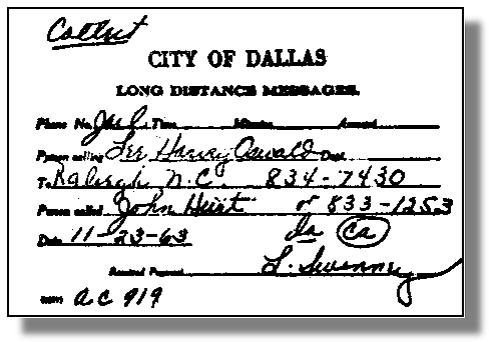
BIBLIOGRAPHY:
- Army Separation Quality Records, Hurt Veterans Administration File, [Undated]
- FBI Memorandum to FBI Director from SAC Charlotte, 7/28/59, Serial 63-5507-1
- FBI Memorandum to SAC Charlotte from Director, 7/23/59, Serial 63-5507-1
- Hospital Summary Diagnoses by Walter Cobbs, M.D., 4/13/72, Hurt Veterans Administration File
- HSCA Letter to Dept. of Defense, 3/13/78
- HSCA Letter to FBI, 11/7/78
- HSCA Letter to FBI, 2/17/78
- HSCA Letter to U.S. Secret Service, 3/1/78
- HSCA Outside Contact Report, 11/7/78
- HSCA Outside Contact Report, 11/9/78
- HSCA Staff Interview of Abraham Bolden, 1/19/78, JFK Document No. 004825
- HSCA Staff Interview of John David Hurt, 4/11/78, JFK Document No. 007993
- HSCA Staff Letter to Alveeta Treon, 11/7/78
- HSCA Staff Memorandum from HSCA Investigator Harold Rose to HSCA Chief Investigator Cliff Fenton, 12/5/77, JFK Document No. 003972
- HSCA Staff Olutside Contact Report, 11/7/78
- HSCA Staff Outside Contact Report, 11/9/78
- HSCA Staff Outside Contact Report, 12/ ? /78
- HSCA Staff Outside Contact Report, 12/4/78
- HSCA Staff Outside Contact Report, 12/4/78, JFK Document No. 013550
- HSCA Staff Outside Contact Report, 3/21/78, JFK Document No. 006516
- HSCA Staff Outside Contact Report, 4/20/78, JFK Document No. 007493
- Letter and Statement from Alveeta Treon to HSCA Staff Counsel Surell Brady, 11/30/78
- Letter from Robert Goff, Legal Counsel, U.S. Secret Service, to HSCA, 3/14/78, JFK Document No. 006463
- Memo from Jim Kostman to HSCA Chief Researcher Donovan Gay, 8/4/77, JFK Document 014830
- NSCA Staff Interview of Louise G. Swinney, 2/6/78, JFK Document No. 005883
- Rating Decision, 3/27/64, Hurt Veterans Administration File
- Records of Disclosure of Information Under Privacy Act, 4/20/78, to Murray Britton, John David Hurt Veterans Administration File
- Telephone Interview of Carolyn Rabon, 12/13/78, HSCA Staff Outside Contact Report, JFK Document No. 13649
- Telephone Interview of Carolyn Rabon, 12/13/78, HSCA Staff Outside Contact Report, JFK Document No. 13650
- Treon Statement [Affidavit]
- U.S. Secret Service Memorandum to U.S.S.S. Washington, D.C. from U.S.S.S. Chicago, [Undated]
- U.S. Secret Service Memorandum to USSS Washington from USSS Chicago
- Veterans Administration Rating Decision Continuation Sheet, 7/27/64, Hurt Veterans Administration File
|
|


